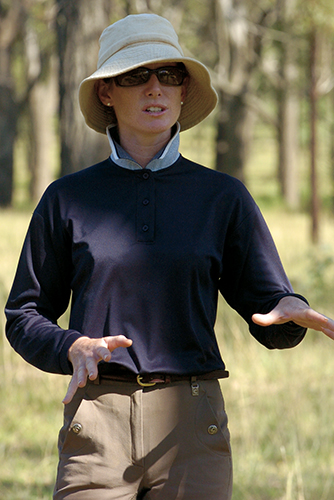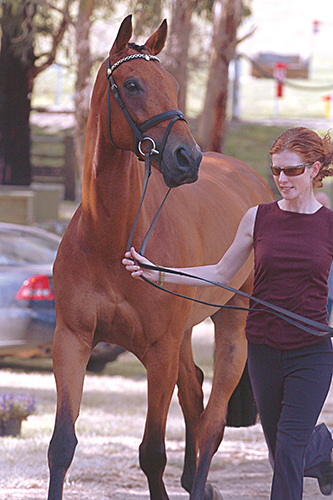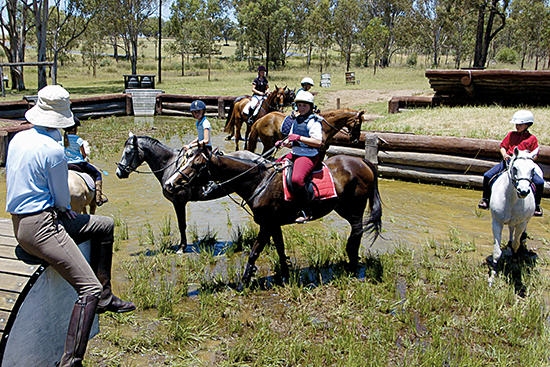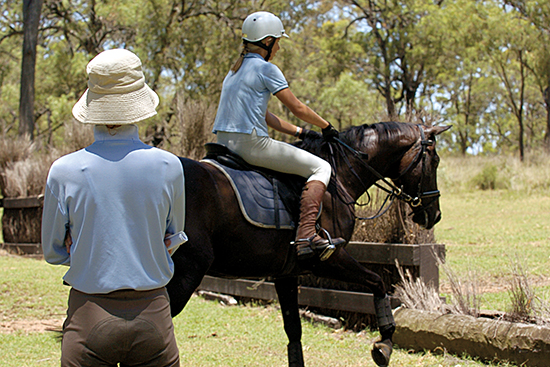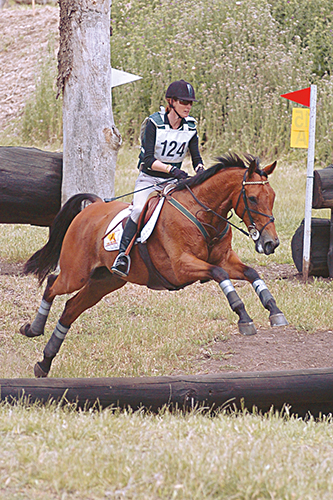 Story by Chris Hector & Photos by Roz Neave
Story by Chris Hector & Photos by Roz Neave
Tarsha Hammond is one of the most stylish of all our eventing riders. To tell the truth, Tarsh is not only stylish on a horse, she is fairly slick just walking around and Tarsh was in great form earlier this year as she talked-the-talk and walked-the-walk with a flock of students following her around the cross-country track at the Warwick Eventing School.
As Tarsha relaxed after a solid couple of sessions guiding horses, ponies, and riders of varying ages and expertise, it seemed like a good time to ask, can you teach cross country?
“What a good question! Yes I think so, because a lot of the things that make you a good cross-country rider, you do need to learn. Things like the defensive seat, getting the pelvis forward as you go into water, and things like that, yeah, that can be taught.”
“I think of all the lessons I had when I was schooling with Heath Ryan and Prue Barrett and those guys at the New South Wales Centre, I definitely was taught it. There are some kids that are naturally brilliant. You watch them ride and they have just got it, a natural knack for it – they ride at a great pace, they have got a great eye, they have got natural guts, they just have it. The rest of us mere mortals have to be taught how to do it.”
“It’s also experience. The more horses you ride, the more mistakes you make, the more you learn. I think schooling and getting taught technique, is very important, because it is the little things that count. You make a mistake with a horse, and then you see someone else making the same mistake, you can say look, this is what helps you learn. It fixes not only the rider but the horse as well.”
“The mind set for cross country is maybe something that is not so easy to teach. It’s something that goes on in your brain when you go cross country, that you have to over-ride the scary bits, and you have to cope with nasty moments and not get too fazed by the knocks, and maybe that can’t be taught.”
There are some riders – like say Prue Barrett – who seem to have that total forward focus, and all sorts of bad things can be happening as they go through or over a jump, but they just keep on coming – and that seems to be an innate quality of those riders?
“I remember seeing Prue Barrett at St Gregs one year, the year they put in the tiny narrow wine barrels. It was a fairly insignificant fence but it caused all this trouble and I was standing there watching, and Prue came in, and she was looking straight ahead, and the horse ducked, left I think it was, and Prue was actually still straight! She’s got her right rein and her left leg and she has just hauled the horse back on line. The horse fully thought it was running out, but there was absolutely no way Prue thought it was running out!”
“I think the things you learn when you watch incidents like that is that the horse was always in front of the leg, and as long as the horse stays in front of your leg, you are alright. As soon as a horse gets back behind your leg, you can’t make a horse do something. You get your eye up, and you keep the horse in front of the leg and you don’t let it drop behind. As soon as you feel it drop behind, you get it back in front, then you are pretty right.”
“Some horses are naturals, like Fred (Fuzzy Logic, the horse that oh so nearly took Tarsh to Athens…), he was always there, bang. But now we are seeing different types of horses, Warmblood influenced horses, they aren’t as naturally in front of the leg and you have to work on that. If you keep your focus forward and the horse in front of your leg, that’s really your cross country technique in action.”
Does that go back to good flat work?
“Exactly, and it is the same with the showjumping I guess. I say it all the time when I teach my dressage lessons, and I say ‘look it is more of a jumping term, but you’ve got to get the horse in front of the leg. As soon as the horse gets behind the leg, you lose 90% of control’. I hate the feeling of a horse behind the leg. They can jack up, do whatever – get it in front of your leg and you are dead right, that’s the basics.”
“I think with cross country you have the extra influence of the fence that makes the horse back off. Something like water can instantly make a horse back off, whereas on the flat it is more often the rider’s hand that puts the horse back behind the rider’s leg. I hate to say it but I think that is why eventers are so good with young horses because they are used to getting them in front of the leg. If you don’t get a horse in front of the leg across country, then you are liable to be hurt. In the dressage if you don’t have them in front of the leg, then you just don’t get them reaching so much, and the horse might get ‘jacky’ on you, but there is more incentive to get it right across country.”
Do you like to school cross-country on an arena, or out on a cross-country course?
“I guess you start your cross country over your showjumps and things like that. You can do your little baby apexes, and your barrels and things like that in the jumping arena. I don’t like taking horses cross country schooling that are so green that you can’t get them in front of your leg. You’ve got to have control and steering before you take them cross-country. So first we do that work in the arena, but then you have to take the horse to the open paddock. It is very good for the pace control. It is different taking a horse to a fence once you have been in open pace and coming back to a more collected pace and the horse’s adrenalin is up. If you go to your first event without having played around with pace, then that first event can be wild.”
“I like to do both. I school my more experienced horses with single barrels, that’s a favourite thing of mine, doing combinations of apexes to single barrels in the arena on a good surface, where it is all very well controlled and if they make a mistake, it comes down.”
“Still I want to go cross country, I guess that comes down to our training at the NSW Centre, and I still try to get down there and use the cross country course for schooling. It is a great schooling course for pre-Novice and above. You spend so much time schooling those fences, then when you get out to a competition, it all comes so easy. I know that when I haven’t spent enough time in the cross country paddock – you get a bit caught up in your dressage or whatever – then when you do go cross country and something goes wrong, the first thing you think is ‘oh well back to the cross country paddock’.”
If you can school riders to go cross-country can you school horses to go cross-country?
“Some of them just take to it. Some are amazing, you start them off, and they are just bold horses. I’ve got a young one at home, and if it sees something, it just bites it – he is an aggressive bold horse. Anything you take him near, it is perfectly happy to jump. It was the same with Fred, everything you asked him to do was easy, then other horses have just got that natural caution. They are like people, they are not as bold but they can be taught – some of them. Some of them just don’t make good eventers. You always wonder with those ones that aren’t naturally bold, when they get into a tight spot somewhere up the grades, are they going to have the guts that it takes?”
Are those bold ones going to be careful enough to handle the demands of the new showjumping requirements?
“That’s the question now. The new format where they have to be so good on the flat, and yet they also have to be so careful. I’ve just sacked a horse because it is too careful, you hate saying they are ‘too careful’ when you go cross-country, but he hits a fence and he just hates it. I don’t think he is going to be bold enough to handle the odd knock, he hates hitting anything, so he is going showjumping. It is that happy balance between bold and careful that is so hard to find.”
Is finding the horse that much harder now – once you used to be able to get there with a horse that was good at two out of three phases…
“I think what we need in the horses has definitely changed, it makes it harder – but that makes it more exciting as well, it makes us focus on our weaknesses. It’s hard for me – I’ve always got my horses off the track, always. I don’t think it means ex-racehorses are necessarily going to disappear; it just means that we have to be more fussy. Once all you had to look for was a bold horse. I think for a while in Australia, we’ve been getting better dressage horses, but not showjumping horses. We just haven’t had tough showjumping courses. That is my weak phase, and that is what I’ve got to work on. The new format takes a different sort of riding.”
With your little students at the Warwick Eventing School, what were you concentrating on?
“Just to get their lower leg strong, to have a strong lower leg and to be able to keep the horse in front of the lower leg, that is important. It is not just for rider security, if the leg slips further back as they get closer to the fence, and the horse goes to hesitate, then the leg is not there to encourage the horse. That’s when horses start to get stally, and things start to deteriorate. They need to keep that lower leg there and keep it there in the air.”
“Working over downhill jumps is good for that because they more or less have to get their legs there. Some of the little kids are so naturally balanced that they find it so easy. They go ‘lower leg, get away, I don’t fall off!!’ and they probably don’t – but as they get older and the horses get bigger and clumsier, and they need more support in front of a fence, then they are going to need that lower leg, so they might as well start now.”
You were also concentrating on hands – so that the riders don’t jag their horses in the mouth over a fence? Or when they land?
“Yeah, I think it is important to think about whenever we are riding a horse, that the bit in their mouth is such a severe connection – a bit of metal in their mouth. I think we’ve got to be careful with our hands. One of the riders was doing a great job but she was just losing her balance and catching the horse, and the horse just remembered that. You’ve got to make every time they leave the ground as pleasant an experience as you can.”
“The other thing you learn as you get older is putting the horse in the right frame so they don’t pull too much and get fighty. You watch Stuart Tinney’s horses travel, they are just perfect, makes you sick, he travels around the cross country in this amazing beautiful connection. But that is what we have got to aim to get.”
People get into bad habits then it is very hard to get rid of them…
“HA, that is a direct reference to my hands! I know I have helium hands! They do go down but they come back up again – and it is the sort of thing I’ve just got slack at. I needed to jump on it years ago – but years ago I was riding 15 horses a day, and the last thing you would be bothered doing is being strict on yourself about your hands. Now it is so annoying. I’m tough on my students. Look my hands get high, but do as I say not do as I do. I will get them down, especially when I am too old for eventing, then I’ll have to get them down to go full time dressage won’t I?”
Thanks Tarsha…


